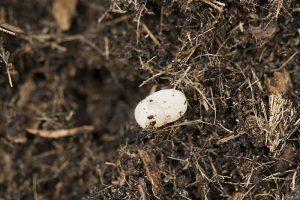Coconut rhinoceros beetle of the rhinoceros subfamily and the scarab beetle family is said to be a native of Asia, particularly Indonesia and India. However, over the years, its population spread to Hawaii, Yemen, and the Reunion Island, where it appeared as an invasive species. They are known to cause significant damage to coconut leaves and several other plants, particularly those growing in the Pacific Islands and parts of tropical Asia.
Size: 30 – 63 mm (1.2 – 2.5 inches)
Color: Their color varies from dark brown to black, with both the sexes’ ventral surface covered with reddish-brown hairs. However, in the females, the hairs are fuzzily arranged near the abdominal tip.
Other Characteristic Features: Sexual dimorphism is visible not just in their color pattern but also in physical appearances. The males have longer horns and a shinier abdominal segment than their female counterparts.
The larvae have a yellowish-white C-shaped body and red head growing to about 60 – 100 mm, in their three instar phase. They mostly grow in the decayed or dead trunks alongcol3 other organic matter and cause no damage to crops.
The pupa closely resembles the adult, having a yellowish-brown membranous exterior that hardens in the last phase of the pupal stage, spanning between 20 and 40 days. They grow to about 50 mm (1.96 inches). The horn-like projections on their anterior part could appear smaller if they are female and larger if the emerging adult is a male.
The whitish-brown eggs are soft and elongated at the onset, transforming to a spherical shape in 4 – 5 days. They are about 3 – 4 mm (0.11 – 0.15 inches) and mostly laid in burrows of dying material.

| Other names | Asiatic rhinoceros beetle, coconut palm rhinoceros beetle |
| Lifespan | 4 – 9 months |
| Distribution | Native: South and Southeast Asia, particularly in Indonesia, Malaysia, Thailand, Vietnam, Myanmar, Philippines, South China, and India Invasive: Hawaii, Yemen, Reunion Island, Fiji, Guam, Solomon Islands, Papua New Guinea |
| Habitat | In and around coconut and palm plantations |
| Common Predators | Pig, ant, rat, other beetle species |
| Seasons active from | June – September |
| Host Plants | Cocos nucifera, Calophyllum inophyllum, Elaeis guineensis, Corypha umbraculifera , Hydriastele palauensis |
| Diet of larva and adult | Larvae: Dead and decomposed plant matter Adults: Leaves and saps of the coconut and palm trees |
The larva feeds on the decayed matter and does not harm plants or crops, and the maximum damage is done by the adults, as their diet comprises fresh leaves and sap. They bore right into the middle of the plant’s crown, drilling through the young fronds. This results in a v-shaped cut in the leaves or even creating several holes through their midribs.
Image Source: looppacificassets.s3.amazonaws.com, lh4.ggpht.com, st.depositphotos.com, upload.wikimedia.org, lh6.ggpht.com, biolib.cz, plantheroes.org
Coconut rhinoceros beetle of the rhinoceros subfamily and the scarab beetle family is said to be a native of Asia, particularly Indonesia and India. However, over the years, its population spread to Hawaii, Yemen, and the Reunion Island, where it appeared as an invasive species. They are known to cause significant damage to coconut leaves and several other plants, particularly those growing in the Pacific Islands and parts of tropical Asia.
Size: 30 – 63 mm (1.2 – 2.5 inches)
Color: Their color varies from dark brown to black, with both the sexes’ ventral surface covered with reddish-brown hairs. However, in the females, the hairs are fuzzily arranged near the abdominal tip.
Other Characteristic Features: Sexual dimorphism is visible not just in their color pattern but also in physical appearances. The males have longer horns and a shinier abdominal segment than their female counterparts.
The larvae have a yellowish-white C-shaped body and red head growing to about 60 – 100 mm, in their three instar phase. They mostly grow in the decayed or dead trunks alongcol3 other organic matter and cause no damage to crops.
The pupa closely resembles the adult, having a yellowish-brown membranous exterior that hardens in the last phase of the pupal stage, spanning between 20 and 40 days. They grow to about 50 mm (1.96 inches). The horn-like projections on their anterior part could appear smaller if they are female and larger if the emerging adult is a male.
The whitish-brown eggs are soft and elongated at the onset, transforming to a spherical shape in 4 – 5 days. They are about 3 – 4 mm (0.11 – 0.15 inches) and mostly laid in burrows of dying material.

| Other names | Asiatic rhinoceros beetle, coconut palm rhinoceros beetle |
| Lifespan | 4 – 9 months |
| Distribution | Native: South and Southeast Asia, particularly in Indonesia, Malaysia, Thailand, Vietnam, Myanmar, Philippines, South China, and India Invasive: Hawaii, Yemen, Reunion Island, Fiji, Guam, Solomon Islands, Papua New Guinea |
| Habitat | In and around coconut and palm plantations |
| Common Predators | Pig, ant, rat, other beetle species |
| Seasons active from | June – September |
| Host Plants | Cocos nucifera, Calophyllum inophyllum, Elaeis guineensis, Corypha umbraculifera , Hydriastele palauensis |
| Diet of larva and adult | Larvae: Dead and decomposed plant matter Adults: Leaves and saps of the coconut and palm trees |
The larva feeds on the decayed matter and does not harm plants or crops, and the maximum damage is done by the adults, as their diet comprises fresh leaves and sap. They bore right into the middle of the plant’s crown, drilling through the young fronds. This results in a v-shaped cut in the leaves or even creating several holes through their midribs.
Image Source: looppacificassets.s3.amazonaws.com, lh4.ggpht.com, st.depositphotos.com, upload.wikimedia.org, lh6.ggpht.com, biolib.cz, plantheroes.org